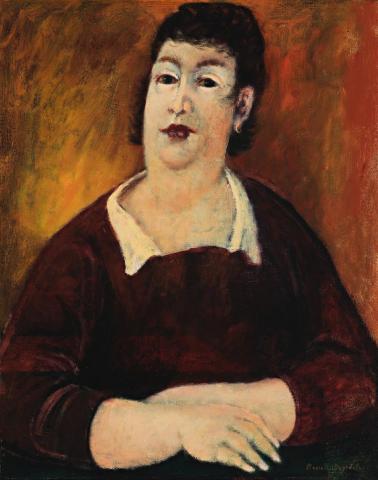MRS. FARDAKAS OF THE ACROPOLIS CAFÉ, 1972
RUSSELL DRYSDALE
oil on canvas
76.0 x 61.0 cm
signed lower right: Russell Drysdale
inscribed verso: "MRS. FARDAKAS OF THE ACROPOLIS CAFÉ" / RUSSELL DRYSDALE / C/o THE LEICESTER GALLERIES / 22A, CORK STREET, / LONDON W.1.
Leicester Galleries, London
Private collection
Geoff K. Gray, Sydney, 13 February 1974, lot 31
Private collection
Sotheby's, Melbourne, 19 August 1996, lot 270
Private collection
Deutscher~Menzies, Melbourne, 10 August 1998, lot 137
Private collection, Melbourne
Deutscher~Menzies, Melbourne, 9 May 2001, lot 100
Private collection, Tasmania
Paintings, Drawings and Watercolours by Sir Russell Drysdale, Leicester Galleries, London, 16 June – 15 July 1972, cat. 25 (illus. in exhibition catalogue, label attached verso)
Klepac, L., The Life and Work of Russell Drysdale, Bay Books, Sydney, 1983, pl. 181 (illus., as 'Mrs Fardakis [sic] of the Acropolis Cafe')
Russell Drysdale's Mrs Fardakas fills the painting with an abundance of form that mirrors her character. Amplitude expresses a distinctive inner strength and big-hearted generosity that singles her out as someone special. She is just like the Acropolis after which her cafe is named. Towering over the city of Athens, the Acropolis is crowned by the Parthenon, one of the greatest architectural treasures the world has ever known. The individual Mrs Fardakas likewise towers over her domain, treasured as a place to frequent for good food and company. One is tantalized by identification. The person and named place resonate with the iconic and metaphoric; but she is too striking not to be real. And it is this realism which is so engaging. Of Drysdale's many talents, his intuitive grasp of the Australian character, both in terms of the country itself and those who peopled it, was his greatest. The Aboriginal figure was presented in total harmony with the landscape. The European settlers were stoic in their endeavours to triumph in a harsh environment; and those who filled the towns showed a similar determination to succeed. Mrs Fardakas's physical presence recalls Drysdale figures from the forties, The Countrywoman, 1946 (formerly the collection of James Fairfax AC, gifted to the National Gallery of Australia, Canberra in 1999), and the prize-winning Woman in a Landscape, 1949 in the collection of the Art Gallery of South Australia, Adelaide.1 It was Drysdale's biographer, Lou Klepac, who described Woman in a Landscape as 'the Mona Lisa of the outback'.2
In Mrs Fardakas of the Acropolis Café Drysdale was also responding to the large influx of Greek settlers who had found their way to Australia. Their presence caught the eye of many other artists. Vic O'Connor's 1944 painting The Greek Cafe had its genesis in the concentration of Greeks in Melbourne, the largest in the world outside Athens and Thessalonica. Donald Friend gave it a Biblical bend in The Prodigal Son - Acropolis Cafe, c1949. Acropolis cafes dotted the land from Albury to Gunnedah.
Drysdale had a high profile in London by the time of his 1972 exhibition in which Mrs Fardakas of the Acropolis Café made a memorable appearance. It was his last London show, our painting being one of twelve, together with a number of drawings and watercolours. The oils included The Boss Drover, 1972, a single Aboriginal figure in an open composition compared with the close and tightly edged Mrs Fardakas. There were also such notable paintings as Woman at a Window, 1969 and Broken Mountain II, c1972. Reviews appeared in London's Burlington Magazine and Arts Review, while Terry Ingram in Sydney had written the previous December about the anxious wait of collectors upon the coming show.3
1. Woman in a Landscape was awarded the 1949 Melrose Prize amid an Adelaide controversy akin to the Archibald row in Sydney five years before.
2. Klepac, L., The Life and Work of Russell Drysdale, Bay Books, Sydney, 1983, p. 94
3. 'Leicester Galleries', Burlington Magazine, London, August 1972, cxiv, p. 571; Wykes-Joyce, M., 'Russell Drysdale', Arts Review, London, 1 July 1972, p. 393; Ingram, T., 'Collectors Wait on Drysdale Showing', Australian Financial Review, Sydney, 9 December 1971
DAVID THOMAS
